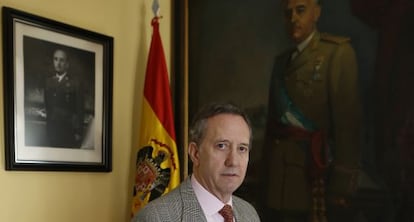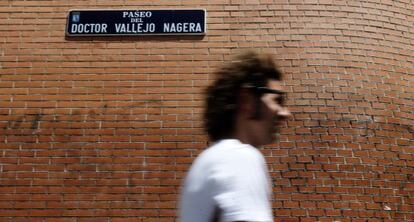What is left of Franco’s legacy?
The Francisco Franco National Foundation still honors the memory of the former dictator

In one of the Spanish capital’s more upscale neighborhoods, just a stone’s throw from Real Madrid’s Santiago Bernabéu stadium, an anonymous apartment block hides one of the last bastions of the dictatorship of General Francisco Franco. Images of the military leader’s face adorn every wall in each of its six rooms, along with drawings, busts, photographs and even tapestries.
Welcome to the Francisco Franco National Foundation (FNFF), an institution that insists history has been “manipulated” and has “hidden” all that was “at stake” during the Spanish Civil War: “Western civilization and Christianity.” It also claims that the state “in which we still live” was built during the dictatorship’s 40-year life. In short, 40 years after his death, Franco’s legacy is still with us.
With time, I saw that it was difficult to find anything he had done wrong” Francisco Franco National Foundation vice president Jaime Alonso
Set up to defend the memory of the man who plunged the country into almost three years of civil war, the FNFF has an annual budget of between €70,000 and €90,000 from private donations. “They can remove the plaques and the statues, but this is part of history and should be respected,” says Jaime Alonso, the foundation’s vice president.
Spain’s Royal History Academy, which in the 2011 update of its encyclopedia of the country’s leading figures, preferred not to call Franco a dictator, is about to rectify that in a new edition.
But the FNFF insists not: comparing Franco to say, Hitler, “is to ignore the nature of what he was,” says Alonso, who was aged 23 when Franco died on November 20, 1975.

“With time, I saw that it was difficult to find anything he had done wrong,” says Alonso, whose father fought for Franco. “I have never known anybody more honorable than my father. That is why I defend the honor of the regime, because I have lived through it with him and his friends.” His vision of the dictator, who signed his last death sentences just months before his own passing, has angered the victims of Franco, as well as opposition parties. There have even been calls for the FNFF to be banned.
There are still any number of streets and public places in Spain bearing the names of those associated directly with the Franco regime, or that recall the date of the uprising on July 18, 1936, or commemorate battles: there is still a statue dedicated to Franco in the North African enclave of Melilla. And this despite a Historical Memory law passed in 2007 that expressly calls for the removal of “shields, insignia, plaques, and other objects or commemorations paying tribute to the military uprising, the Civil War, and the repression of the dictatorship.” Nevertheless it took years of protest before the authorities in the northern port city of Oviedo removed a bust of Franco.

The disappeared, trials and Masses
So just what does remain of Franco’s legacy four decades after his death? The United Nations says more than 100,000 bodies of people who were murdered by Franco’s forces during and after the war are still lying in unmarked mass graves – although Alonso dismisses this as “yet another of the left’s complexes, which require psychiatric treatment.” There are myriad crimes yet to be investigated, such as the beatings and “torture” committed by former police officer Juan Antonio Gómez Pacheco, known as Billy the Kid. Then there is the Valley of the Fallen, which was built to honor the men who died fighting for Franco and remains the dictator’s resting place. Alonso insists that just 23,000 people were killed by Franco’s forces, and “all were shot after a court martial.”
Those responsible for war crimes committed by Franco’s forces have never been tried, as the UN’s Human Rights Committee pointed out early this year: “Spain needs to make sure that those responsible [for war crimes] are identified, tried, and subjected to the appropriate sanctions.” The UN report expresses its “concern” about the failure of the Spanish authorities to clarify human rights violations, and says that a 1977 amnesty should be annulled. Alonso insists that the amnesty did not “favor” anybody from the regime, “as some would argue today.”
The coming days will see at least 16 Masses held in honor of Franco throughout Spain
The coming days will see at least 16 Masses held in honor of Franco throughout Spain. For its part, the FNFF will be holding a dinner on December 3 at a four-star hotel in Madrid. “We are trying to destroy the myths surrounding the man who freed Spain from Communism, who brought prosperity to the Spanish people, created a large middle class, and brought about the reconciliation that allowed for the monarchy to be restored and the transition to democracy begun,” says Alonso, playing down the absence of civil and political freedoms or human rights.
Alonso is similarly dismissive of the need for Spain to investigate allegations of torture and repression during the Franco years: “That’s like investigating a car accident that happened in 1972. I lived through those times. I was at university. The people challenging the police had a great time. It was a way of showing that you were young. Those who went to jail, if they were tortured, and I’m sure there was the odd case, were probably just hit a few times unnecessarily. But that’s how things were at that time. They weren’t democracts, they were Communists. Nowadays it doesn’t make sense to punish people for what they think, but it did then.”
The only court in the world that seems interested in bringing to justice those responsible for crimes against humanity committed during the Franco era is in Argentina. In part this reflects the country’s efforts to come to terms with its own dark past during the military dictatorship that ran the country between 1976 and 1983. Some on the right wing of politics in Argentina still defend the regime, while the country’s institutions are still unwilling to come to terms with what happened or bring those responsible to justice, as was pointed out in March of this year by historian Mirta Núñez Díaz-Balart, who holds the professorship of Historical Memory at Madrid’s Complutense University. “A genuine truth commission set up by the state has not been created, although this was a bloody dictatorship, and the little that has been done has had little funding and been left to private associations and the families. Some things have been done well that have not worked, such as the Historical Memory Law.”
The visible and the invisible
What remains is what can still be seen, as Alonso points out: “Buildings, a lot of infrastructure, roads, reservoirs…” And also the aforementioned Valley of the Fallen, not to mention others, less well known: the Victory Arch in Madrid, finished in 1956 to commemorate the Civil War battles in the capital’s university district; the ruins of the village of Belchite, in Zaragoza, which were destroyed in the battle of the same name and that Franco decided to leave as a reminder of the war, ordering the new village to be built nearby; the monument to the Baleares, a nationalist troop ship sunk by the Republicans during the war, in Palma de Mallorca; and Llanos del Caudillo, one of the 300 or so new communities built by the National Colonization Institute in the early 1950s.
And what is left that we’ve forgotten about? Alonso again cites the construction “of the state we’re still living in.” There’s more: the long-running project to transfer water from the Tajo and Segura rivers, which was first begun in 1966 (although the idea dates back to the beginning of the 20th century); the bonus paid to newspaper kiosk owners each July 18 (to mark the uprising in 1936); and on December 23, when the results of the National Lottery are published, ticket sellers receive a 40 percent commission on what they sell, instead of the normal 20 percent.
Video: A Spanish newsreel showing the monument to the Baleares, a nationalist troop ship sunk by the Republicans during the war, in Palma de Mallorca.
On top of that there is also Spain’s tradition of an extra salary payment in summer and at Christmas, which Franco introduced in 1947 after wages were lowered; longer working hours, introduced in the 1960s, along with higher living costs; and the 1954 law allowing the state to forcibly expropriate properties, which has barely been amended since – residents in the small community of Chapela, in Galica, who oppose the extension of the AP-9 toll road stand to lose their homes as a result of it.
There’s also the 1964 law that allows the state to send in the military in the event of a dispute with air traffic controllers – applied in 2010 by the previous Socialist government – and a 1946 law that allows the Catholic Church to register unclaimed property in its name.
Other traditions remain in place, such as the hunting trips that bring together elected officials and business leaders to quietly do deals sealed with a handshake over a pile of slaughtered animals. Then there are the US military bases, the obsession with Spanish unity at all cost, the privileges that the Catholic Church continues to enjoy, and the use of the titles Don or Doña, used before all the names of the members of the FNFF, and employed by Jaime Alonso, who, when he discreetly kisses the hand of this reporter, reveals cufflinks bearing the colors of the flag of Spain.
Tu suscripción se está usando en otro dispositivo
¿Quieres añadir otro usuario a tu suscripción?
Si continúas leyendo en este dispositivo, no se podrá leer en el otro.
FlechaTu suscripción se está usando en otro dispositivo y solo puedes acceder a EL PAÍS desde un dispositivo a la vez.
Si quieres compartir tu cuenta, cambia tu suscripción a la modalidad Premium, así podrás añadir otro usuario. Cada uno accederá con su propia cuenta de email, lo que os permitirá personalizar vuestra experiencia en EL PAÍS.
¿Tienes una suscripción de empresa? Accede aquí para contratar más cuentas.
En el caso de no saber quién está usando tu cuenta, te recomendamos cambiar tu contraseña aquí.
Si decides continuar compartiendo tu cuenta, este mensaje se mostrará en tu dispositivo y en el de la otra persona que está usando tu cuenta de forma indefinida, afectando a tu experiencia de lectura. Puedes consultar aquí los términos y condiciones de la suscripción digital.
Últimas noticias
The complicated life of Francesca Albanese: A rising figure in Italy but barred from every bank by Trump’s sanctions
From digital curfews to blocking apps: How technology experts protect their children online
Why the price of coffee has skyrocketed: from Brazilian plantations to specialty coffee houses
Confined to a Cuban hospital: When electricity is a matter of life or death
Most viewed
- Pablo Escobar’s hippos: A serious environmental problem, 40 years on
- Why we lost the habit of sleeping in two segments and how that changed our sense of time
- Trump’s obsession with putting his name on everything is unprecedented in the United States
- Charles Dubouloz, mountaineering star, retires at 36 with a farewell tour inspired by Walter Bonatti
- The Florida Keys tourist paradise is besieged by immigration agents: ‘We’ve never seen anything like this’








































